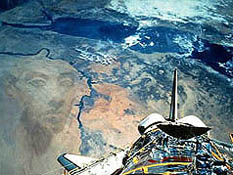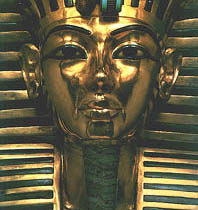|
An educational Forum based on new Ariticle #7 Tutankhamun/ The Trinity of Christ © Ahmed Osman 2001 |
Present
Version is WTheaux visited |
Overview and comments by
contributing |
|
TUTANKHAMUN AND THE TRINITY OF CHRIST In his interesting account of Velikovesky's Worlds in Collision (FT 118), Niklas Rasche referred to my argument of the similarities between Pharaoh Akhenaten and both Moses of the Bible and Oedipus of Greek mythology. Tom Holland had, in an earlier issue Akhenaten (FT 117), given more details of my identification of Akhenaten with Moses, but he went on to say: "The naming of Akhenaten as the founder of the Jewish religion seems positively restrained compared with Osman's real bombshell, his revelation that Tutankhamun had, in fact, been Jesus Christ." The early Fathers of the Church accepted that Jesus appeared, not once, but twice: First in the person of Joshua the son of Nun, who succeeded Moses as the leader of the Israelites in the 14th century BC, and again when, in his Glory, he appeared to the disciples in the 1st century AD."Jesus" is the Greek form of"Joshua," which appeared for the first time in the Greek translation of the Old Testament made in Alexandria during the 3rd century BC. When the Gospels were written, also in Greek, it was understood that Jesus Christ was the same person as the Israelite leader who succeeded Moses. The confusion between the two forms of the name only appeared from the 16th century onwards, when the Bible was translated into English. Only then was the name "Joshua" given to the Old Testament character, while "Jesus" was used for his New Testament appearance. As I've come to the conclusion that Akhenaten was the same as Moses, I also concluded that Akhenaten's successor was the same as the leader who succeeded Moses. Akhenaten, king of Egypt (1378-1361 BC.), was the first monotheistic ruler in history. He abolished the worship of the different gods of Ancient Egypt and introduced a deity with no image—Aten, the biblical Adonai—to be the sole God for all people. In his 17th year, Akhenaten was overthrown by a military coup when he used the army to force the new religion on his people, and was replaced by Tutankhamun in 1361 BC. Akhenaten then went into exile in Sinai, accompanied by some of his followers. Recognizing that ordinary people need a physical object for their worship, Tutankhamun allowed the ancient deities to be worshiped again, but only as mediators between Aten and his people. Ernest Sellin, a German biblical scholar, had found textual evidence to suggest that an Israelite leader was murdered in Sinai, and Sigmund Freud thought this leader was Moses. The Israelites, he thought, killed Moses as they resented his strict teachings. I was able, however, to identify the assassinated leader as Joshua the son of Nun, successor of Moses. It was Phinehas, the priest of Moses, whom I've identified with Pa-Nehesy the high priest of Akhenaten, who killed Joshua. While the Israelites were still in the land of Goshen in Egypt, Pa-Nehesy killed Tutankhamun at the foot of Mount Sinai, as he regarded him as a heretic who allowed paganism's return. In the tomb of Tutankhamun there is a unique scene, not found in any other Egyptian burial, representing the Trinity of Christ. The profound significance of the wall-painting escaped me until November 1997 when I was invited by General Mohamed Yusef, the then governor of the city of Luxor, to speak in the city hall as part of the 75th anniversary celebration of the tomb's discovery. Afterwards I was privileged to have a private visit to the tomb. As I stood alone, gazing at the painting of the burial chamber on the north wall, I realized for the first time that I was looking at the strongest pictorial evidence linking Tutankhamun and Christ. The painting is divided into three separate scenes. The first scene on the right shows Aye, already crowned as the king's successor, but nevertheless officiating as a priest dressed in the leopard skin, performing the ritual of "the opening of the mouth" for resuscitation of the dead Tutankhamun, who is shown as a risen Osiris. The middle scene shows Tutankhamun entering the heavenly realm of the gods and being welcomed there by the sky goddess Nut. It was the ultimate scene on the left of the north wall, however, that aroused my wonder. Here I saw three different representations of Tutankhamun linked as one person. On the left of the scene stood Tutankhamun as the risen Osiris, with a second Tutankhamun facing him as the ruling king, Horus. Behind him is a third Tutankhamun depicted as his Ka. The most remarkable feature of this scene is the fact that the risen Osiris, although shown in the conventional mummified form with his hands folded across his chest, is reaching out to touch Horus, as is his Ka. Thus we have Tutankhamun as father, son and spirit—the same relationship that we find in the Christian Trinity of the three persons in one God—Father, Son and Holy Spirit—finally established as orthodox belief after much acrimonious debate during the first four centuries of the Christian era. Ahmed Osman Historian, lecturer, researcher and author, Ahmed Osman is a British Egyptologist born in Cairo His four indepth books clarifying the history of the Bible and Egypt are: Stranger in the Valley of the Kings (1987) - Moses: Pharaoh of Egypt (1990) - The House of the Messiah (1992) - Out of Egypt (1998) |
|
|
|

